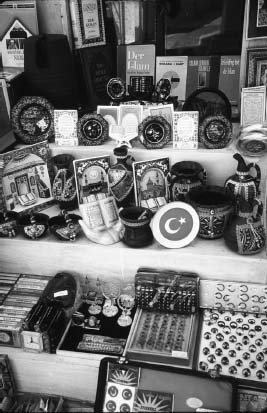IslamCustoms and Rituals |
What kinds of ritual objects figure in Muslim worship and prayer? |
By far the most important ritual object is the Qur’an. Since Muslims regard the sacred book as the very word of God, they try to treat the physical object with the greatest respect. Some mosques own ancient and beautifully wrought Qur’ans, often in multiple volumes, that are used only for special occasions. The more ancient the mosque, the more likely it will also have specially crafted podiums on which to place the Qur’an, and possibly also storage containers. Both stand and box often feature carefully chosen inscriptions from the Qur’an and Hadith that remind devotees of the divine origin and power of the sacred word. One of the most important among the relatively few other items that have been a regular part of Muslim devotions is the classic prayer rug. Displaying a central shape that recalls the mihrab on the Mecca-facing wall of the mosque, high-quality prayer rugs often use geometric and floral designs inspired by the Qur’an’s “Verse of Light”: “God is the light of the heavens and the earth. His light is like a niche in which is a lamp within a glass like a shining star kindled from a sacred olive tree neither of east nor west whose oil would nearly glow even if no fire touched it” (Qur’an 24:35). Inspired by the same verse, beautifully enameled glass lamps were once raised to a fine art and hung by the dozens in the great mosques of the Middle East. The shimmering light cast through their multicolored Qur’anic inscriptions and arabesque designs would have been similar to that cast through Europe’s stained-glass windows.
Are music and dance important in Islamic religious ritual?
Muslims do not incorporate either music or dance into their primary religious rituals, and they use no musical instruments as part of communal worship. Though Muslims do not as a group sing hymns or other types of vocal prayer set to music, a type of tonal recitation is very much a part of Islamic religious life. A “call to prayer” (adhan) broadcast from the minaret (at least in areas where Muslims are the majority population) announces each of the five daily times for salat. The muezzin (pronounced muEZzin) makes the call using a form of chanting that can strike the ear as very musical, even though it has no melody such as we generally associate with songs. Formal “recitation” of the Qur’an is perhaps the closest approximation to music in Muslim ritual. Specially trained reciters, who typically have memorized the entire Qur’an, chant texts of the scripture using either of two styles of presentation. The simpler form is called “measured” and is sung with a recurring pattern of only four or five notes. A more ornate form, called “embellished,” uses a much wider tonal range, proceeds much more slowly, and punctuates the text with dramatic silences. Such recitation can be part of any religious observance in any venue. Outside of primary ritual contexts, Muslims all over the world have set religious themes and sentiments to music in countless local and regional styles and languages. Muslim musicians and singers across the globe are now producing devotional music for mass-market consumption. From Morocco to Indonesia, tapes and CDs filled with contemporary musical interpretations of classical texts and prayers are becoming increasingly popular. Dancing often accompanies popular musical performances, especially those associated with the feasts of local holy persons.

Islamic ritual and devotional objects in a mosque shop, Turkey.
